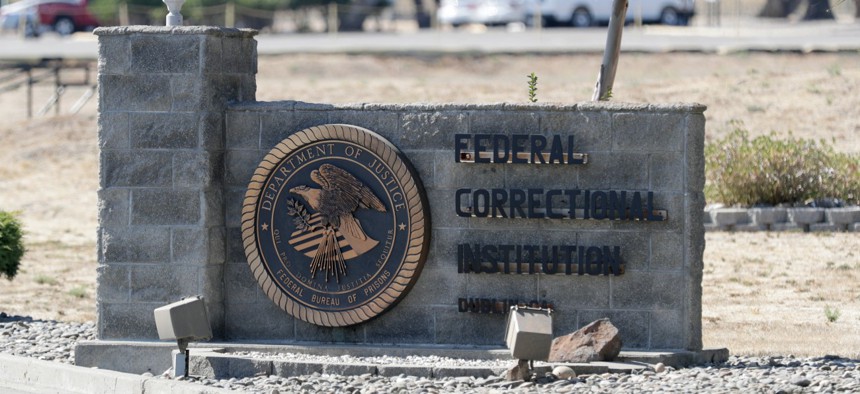
The Dublin Federal Correctional Institution shown here on Sept. 13, 2019 in Dublin, Calif. The Bureau of Prisons has been highly scrutinized and criticized by lawmakers, union officials and others for its response to the pandemic. Anda Chu/MediaNews Group/The Mercury News via Getty Images
Biden Moves to Improve Public Health Conditions in Federal Prisons and Jails
The president is advancing an initiative included in an executive order on increasing police and criminal justice accountability.
The president instructed the Justice Department on Wednesday to take various steps over the next seven months to improve public health and conditions overall in federal jails and prisons.
This directive was part of the executive order President Biden signed on the second anniversary of the killing of George Floyd, an unarmed Black man, by Minneapolis police, which sparked nationwide protests for racial justice on increasing accountability in policing and criminal justice practices. The Justice Department inspector general has repeatedly flagged, “maintaining a safe, secure, and humane prison system” as a top management challenge for the Justice Department, which houses the Federal Bureau of Prisons and U.S. Marshals Service.
“For the duration of the [Health and Human Services Department] public health emergency declared with respect to COVID-19, the attorney general shall continue to implement the core public health measures, as appropriate, of masking, distancing, testing, and vaccination in federal prisons,” the executive order stated.
Furthermore, the attorney general must do the following within 120 days of the order’s enactment: update BOP and USMS’s COVID-19 testing procedures, in consulting with the HHS secretary, for staff and inmates; update BOP and USMS’s protocols with alternatives to facility lockdowns and restrictive housing to prevent the spread of COVID-19; and determine how many individuals who meet the requirements to be released on home confinement, the executive order reads.
There are currently 6,191 inmates on home confinement and the total since March 2020, including those who have finished their sentences, is 42,427, according to BOP’s data.
As of Wednesday, there were 88 inmates and 236 BOP staff with active COVID-19 cases; 51,448 inmates and 12,702 staff have recovered; and 295 inmates and seven staff have died as a result of COVID-19, according to BOP’s data,
The attorney general must also expand the sharing and publication of BOP and USMS’s data on staff, prisoners and detainee vaccinations, testing, fatalities “in a manner that ensures the thoroughness and accuracy of the data; protects privacy; and disaggregates the data by race, ethnicity, age, sex, disability, and facility, after consulting with the White House COVID-19 Response Team, HHS, and the Equitable Data Working Group,” said the executive order.
BOP’s website already has data on facilities operational levels, vaccinations, COVID-19 cases as well as various iterations of COVID-19 related policies and guidance. Its response to the pandemic has been highly scrutinized and criticized by lawmakers, union officials and others, which Michael Carvajal, BOP director, has repeatedly contested during congressional hearings over the past two years.
USMS also publishes data on COVID cases among prisoners in its custody and information on its COVID-19 policies.
Besides COVID-19, the executive order has other requirements to improve confinement conditions.
The attorney general must within 180 days of the order submit a report to the president that outlines actions the DoJ is taking to limit the use of restrictive housing for inmates and within 240 days, conduct a review and submit a report to the president on planned steps to improve quality of and access to medical care (including the specific needs of women and juveniles), recovery support services and environmental conditions for those in BOP and USMS’s custody.
BOP declined to comment on the executive order itself. However, in general, “it is the mission of the [BOP] to operate facilities that are safe, secure, and humane,” said Benjamin O’Cone, BOP spokesperson, told Government Executive on Thursday. “We take seriously our duty to protect the individuals entrusted in our custody, as well as maintain the safety of correctional staff and the community.” The executive order also touched on reentry efforts, which O’Cone, also commented on generally.
USMS did not respond by the time of this article’s publication.
Jason Wojdylo, vice-president for law enforcement operations of the USMS chapter of the FMA, who recently retired from USMS, said “managing the treatment of COVID and mitigating its spread was not necessarily exclusive to the correctional environment,” as nursing homes, homeless shelters and other environments where people are in close quarters faced similar challenges.
“It was often ‘learn as you go’ in uncharted territory, he said.
Shane Fausey, president of the National Council of Prison Locals, told Government Executive on Thursday that, “a lot of the recommendations we already effectively accomplish, however the administration has failed to fully address the staffing crisis that has persisted for many years,” when asked about the order.
The staffing shortage has led to “inadequate responses to the pandemic, escalating prison violence, increases in contraband and illegal activity, and hundreds of unnecessary deaths,” said Fausey. “To be successful, sincere efforts begin with adequate correctional officers and employees to safely operate our facilities, addressing their inadequate and lagging pay, improving their working conditions and reducing abusive levels of overtime.”
He “eagerly await[s] a fruitful meeting with the administration and the attorney general.”
Biden’s fiscal 2023 budget proposal requests $8,177.1 million for BOP, which is a 4.2% increase over his fiscal 2022 request and a 1% increase over the fiscal 2022 enacted level. As for the Marshals Service, he requested $3,956 million, which is a 3.4% increase over his fiscal 2022 budget request and a 6.4% over the fiscal 2022 enacted level.







